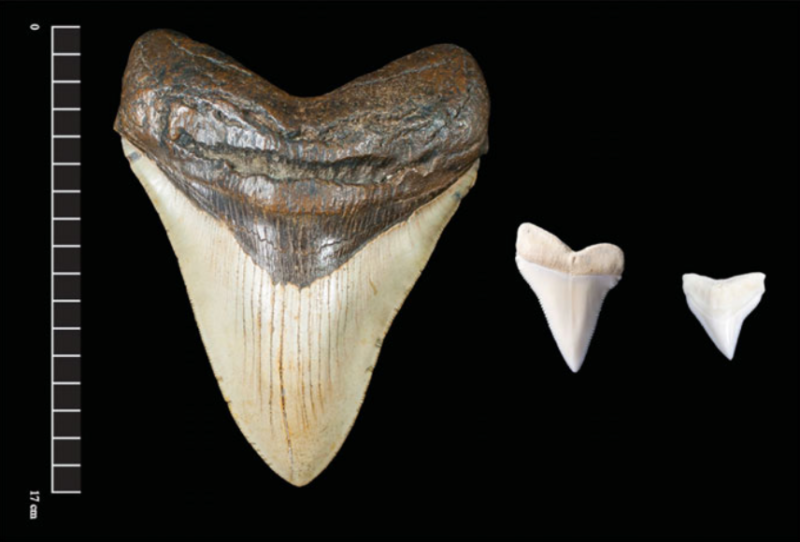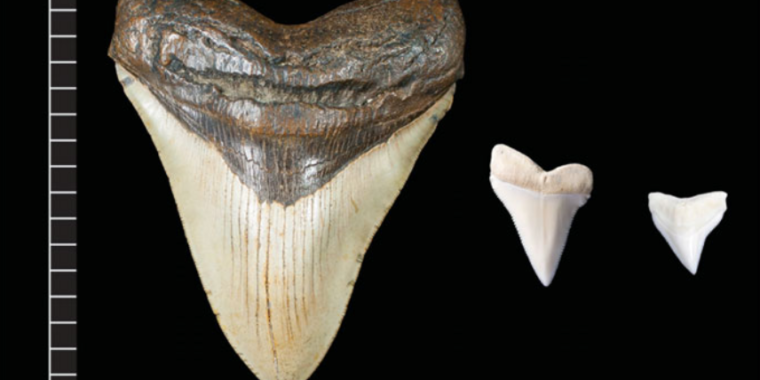Megalodon wasn’t as chonky as a great white shark, experts say
Still a pretty impressive size —
Fresh evidence points to megalodon being longer, more slender than previous depictions.

Enlarge / These are the kinds of shark teeth discovered in burial sites and other ceremonial remains of the inland Maya communities. From left to right, there’s a fossilized megalodon tooth, great white shark tooth, and bull shark tooth.
Antiquity
The megalodon, a giant shark that went extinct some 3.6 million years ago, is famous for its utterly enormous jaws and correspondingly huge teeth. Recent studies have proposed that the megalodon was robust species of shark akin to today’s great white sharks, only three times longer. And just like the great white shark inspired Jaws, the megalodon has also inspired a 1997 novel and a blockbuster film (2018’s The Meg)—not to mention a controversial bit of “docu-fiction” on the Discovery Channel. But now a team of 26 shark experts are challenging the great white shark comparison, arguing that the super-sized creature’s body was more slender and possibly even longer than researchers previously thought in a new paper published in the journal Paleontologia Electronica.
“Our study suggests that the modern great white shark may not necessarily serve as a good modern analogue for assessing at least certain aspects of its biology, including its size,” co-author Kenshu Shimada, a palaeobiologist at DePaul University in Chicago, told The Guardian. “The reality is that we need the discovery of at least one complete megalodon skeleton to be more confident about its true size as well its body form.” Thus far, nobody has found a complete specimen, only fossilized teeth and vertebrae.
As previously reported, the largest shark alive today, reaching up to 20 meters long, is the whale shark, a sedate filter feeder. As recently as 4 million years ago, however, sharks of that scale likely included the fast-moving predator megalodon (formally Otodus megalodon). Due to incomplete fossil data, we’re not entirely sure how large megalodons were and can only make inferences based on some of their living relatives, like the great white and mako sharks.
Thanks to research published last year on its fossilized teeth, we’re now fairly confident that it shared something else with these relatives: it wasn’t entirely cold-blooded and apparently kept its body temperature above that of the surrounding ocean. Most sharks, like most fish, are ectothermic, meaning that their body temperatures match those of the surrounding water. But a handful of species, part of a group termed mackerel sharks, are endothermic: They have a specialized pattern of blood circulation that helps retain some of the heat their muscles produce. This enables them to keep some body parts at a higher temperature than their surroundings. A species called the salmon shark can maintain a body temperature that’s 20° C warmer than the sub-Arctic waters that it occupies.
Megalodon is also a mackerel shark, and some scientists have suggested that it, too, must have been at least partially endothermic to have maintained its growth rates in the varied environments that it inhabited. The 2023 study measured isotope clumping—which can provide an estimate of the temperature at which a material formed—in mastodon teeth. They confirmed that the megalodon samples were consistently warmer, with an average temperature difference of about 7° C compared to cold-blooded samples.
Megalodon wasn’t as chonky as a great white shark, experts say Read More »
